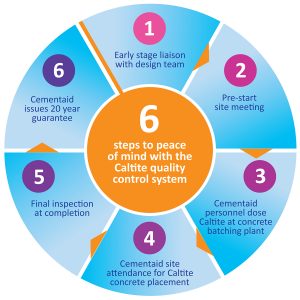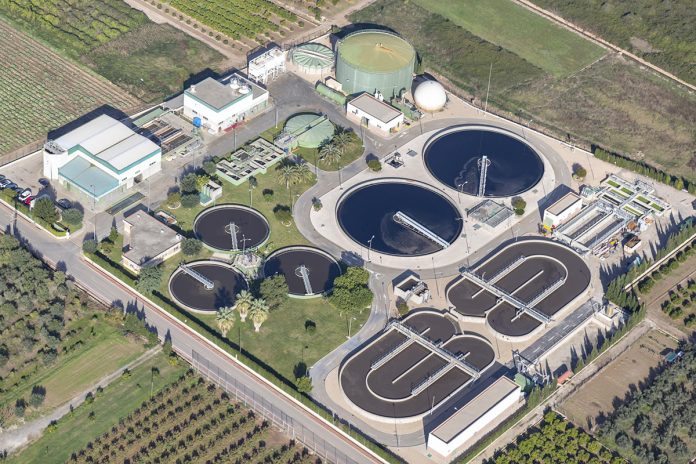Hydrophobic and Pore‐blocking Ingredient (HPI) for corrosion-resistant concrete. Wastewater treatment plants are among the harshest environments for concrete, where there are many causes that degrade concrete and once this process starts, its effects are usually rapid
In very brief and simple terms, the process of sewage treatment involves its transport from houses, offices, hospitals, factories etc to the treatment plant via subterranean tunnels usually made of concrete, like the Thames Tideway Tunnel.
In many cases, the sewage moves along these tunnels by gravity with pumping stations used to lift the sewage where necessary and when it reaches the treatment plant.
The treatment process starts by screening to remove large solid particles followed by a process to remove smaller stones and grit. It then goes into clarifying tanks for the primary treatment stage. The solids sink to the bottom of the tank to form sludge, which is pumped for further treatment.
Water will pass over the top of the tank and enter aeration tanks to starts its secondary treatment phase. Air is pumped into the wastewater to stimulate and multiply good bacteria, which consume nasties in the water before it goes for final treatment by being transferred to settlement tanks.
Here, the bacteria sink to the bottom to form sludge, which can be pumped back into the secondary treatment stage. The water will then receive additional treatment before being discharged into a river or the sea. The sludge that was collected from the primary treatment is then further treated and ends up being used as fertiliser, processed for the extraction of biogas or dried to form cake, both then burnt to generate electricity.
The building of these plants involves the use of huge quantities of concrete and depending on the type and location of the sewage treatment plant, the concrete will suffer deterioration from chemical and biological attack, chloride-induced corrosion of the reinforcement, freeze-thaw stresses and abrasion due to the concrete surface coming into contact with moving solids such as sand, rocks, ice and silt.
For detailed information about the technical side of the chemicals that attack the concrete, search the internet for an article entitled ‘Out of sight, out of mind and often out of order’; this title alone indicates how harsh this environment is for the concrete.
Protecting against chemical and biological attack
 In terms of chemical and biological attack, the problem is that concrete has a pH of about 12, so very alkaline and vulnerable to attack by acids. This level of alkalinity is finite, whereas the attacking acids have an infinite source.
In terms of chemical and biological attack, the problem is that concrete has a pH of about 12, so very alkaline and vulnerable to attack by acids. This level of alkalinity is finite, whereas the attacking acids have an infinite source.
Sewage contains sulphate-reducing bacteria and in the presence of oxygen and hydrogen, and a complicated series of chemical reactions the concrete ends up being attacked by sulphuric acid. What makes this worse is that due to the porosity of concrete, this acid gets sucked into the concrete so that the deterioration occurs ever deeper.
The steel reinforcement in the concrete is protected by the high alkalinity of the concrete. However, this protection will be lost if moisture, chloride ions and oxygen penetrate pores or cracks to reach the steel. Once this happens, local corrosion cells will be formed and the steel will start to oxidise.
This process increases the volume of the steel to create tensile forces in excess of the tensile strength of the concrete, which causes cracking in the concrete and once this happens, the extent of damage quickly increases. Stainless steel has been proposed to counter this issue; unfortunately, metals such as stainless steel (steel with added nickel and chromium) oxidise as well, just a bit more slowly.
In climates with cold winters, concrete will degrade when exposed to differential thermal conditions, where one face is much colder than the other, wetting and drying of the concrete on different sides and intermittent exposure to water in freezing temperatures. Such conditions will result in cracking and continuous spalling of the concrete.
Waterproof concrete
The Caltite waterproof concrete system is a time-proven, practical system which produces damp-proof, highly durable concrete.
Caltite and Cementaid have a successful track record of over 50 years helping designers, developers and owners protect concrete structures, even under the most aggressive conditions and was used in some 600,000m3 of concrete in two of the world’s most notable sewage treatment schemes, the Hong Kong Harbour Area Treatment Scheme and the Singapore Changi Water Reclamation Plant, which can treat 1.7 million and 2.4 million cubic metres of wastewater per day respectively.
If you are involved in a project where real concrete durability is important, please contact Cementaid to discover how Everdure CALTITE concrete can work for you and the huge cost savings that can be made by making structures last, info@cementaid.co.uk or telephone Greg Waring on 01293 653 900.
Alistair McDonald
1 Baird Close, Crawley, RH10 9SY
Tel: 01293 653 900
Please note: this is a commercial profile.














